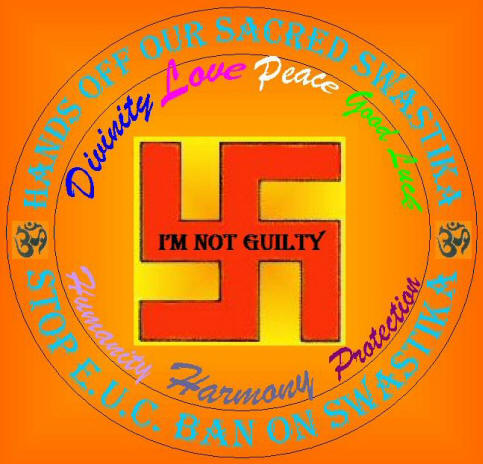
Origins of the Suavastika & Swastika, Worldwide, As Told in the World’s Oldest Language, Symbolism
“The Swastika, the Earliest Known Symbol, and Its Migrations”. What Every Westerner Should Know.

A kind contribution toward the education of the European Union Commission. (Someone please forward this article to all the members)
Don't hide history, learn from it! "Please don't forget who you are"
The swastika is over 14,000 years old and has a worldwide history.
Hitler used the swastika for 10 years as a symbol of the power of the whirling SUN.
Does this mean that we should give up 14,000 years of influence it has had in our World Culture???
By Joseph O. Gill May 9 2011
Joseph O. Gill, the author, at the historical Port Elizabeth Public Library, South Africa 2011
Joseph Gill has talked for over 8 hours on national syndicated talk radio shows with 6 to 7 million listeners about symbolism and the simple origins of our different world religions. After many personal requests Joseph has put together this simple picture documentary article for easy understanding and has supplied references for those people wanting more information details. Go as far as you want.
This paper is given after 40 years of research in thousands of books and 50 years of travel 1961-2011; personally visiting hundreds of churches and temples in over 100 countries.
PLEASE FORWARD THIS LINK TO ALL ON YOUR EMAIL LIST
Symbolism, as I have understood it over the years of my study, are basic images from our own natural environment, used to insight certain specific feelings in our subconscious. Symbols are repeated over and over through all the world religions and into every aspect of our daily lives.




Original Symbol for Coca Cola, General Electric Co. & The Boy Scouts of America
The caduceus (see # Origins of the Caduceus, As Told in the World’s Oldest Language, Symbolism # 2) is three dimensional not two as it is usually seen drawn on a paper or carved on a flat surface. When you look straight down on the caduceus the 2 serpents remind you of the 2 swastika’s. The "Suavastika" which Max Müller named and believes was applied to the Swastika sign, has the ends bent to the left or counterclockwise (Female sign). The Swastika, has the ends bent to the right or clockwise (Male sign).
See “The Swastika, the Earliest Known Symbol, and Its Migrations” - Thomas Wilson, Smithsonian Curator, 1894, page 767.
Suavastika female AND Swastika male


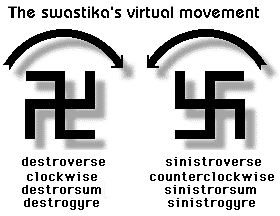


Suavastika female AND Swastika male

“The Swastika, the Earliest Known Symbol, and Its Migrations” - Thomas Wilson, Smithsonian Curator, 1894
Download this and other books FREE on the swastika at
www.archive.org
See Symbolism - Swastika
This report presented by Thomas Wilson Curator, Department of Prehistoric Anthropology, U.S. National Museum, in 1894. The general public needs to be educated about the Swastika, one of Nature/Sun Worship’s oldest and most holy of symbols. Since this report was made long before the misuse of this holy symbol by the Nazi's you will find an unprejudiced presentation of the Swastika and its history. Read on and learn the true history of this holy symbol.
A Collection of Swastika Types
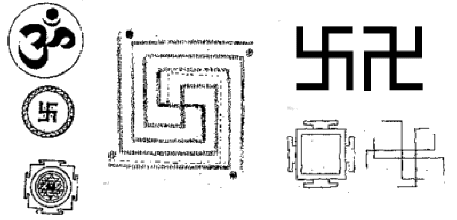




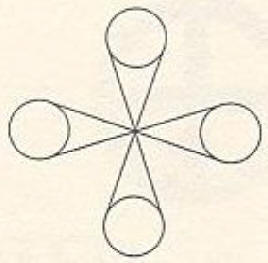
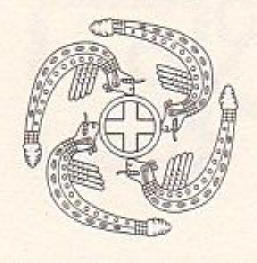
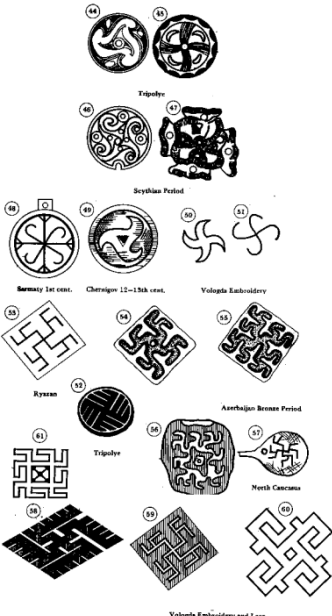

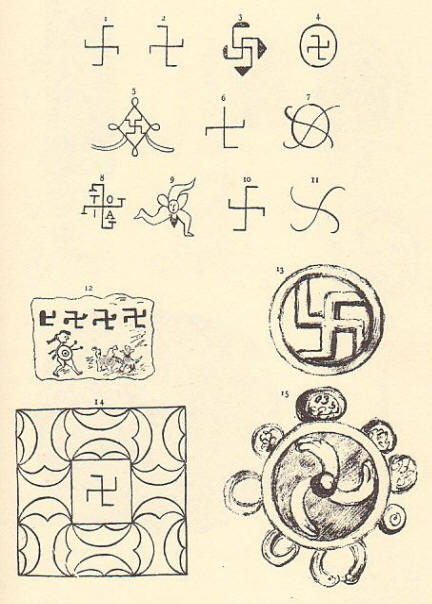



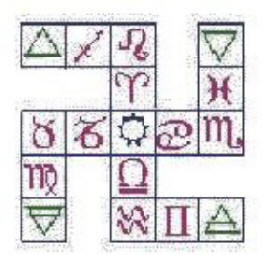

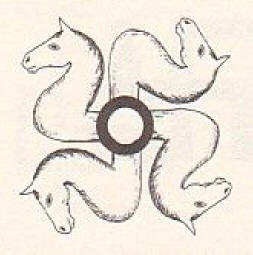
A Collection of Swastika Types

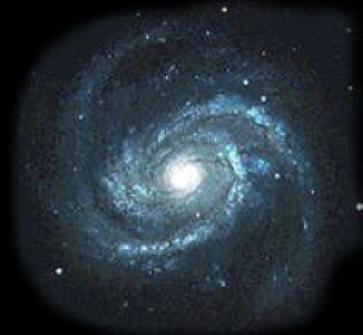
Nature’s Swastikas
Ancient Swastikas


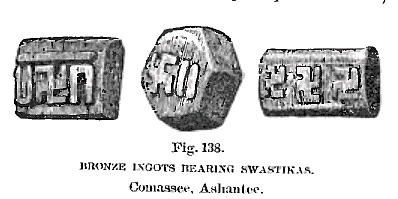


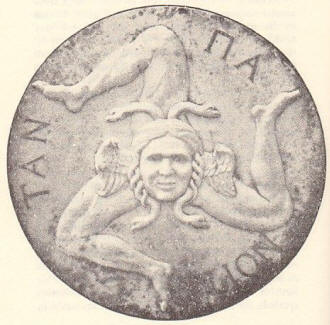



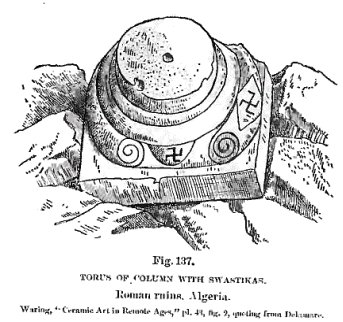


Ancient Swastikas
After seeing thousands of swastikas around the world in both ancient sites and modern times I feel I have learned its real meaning. The Greek name for swastika is Gammadion after the third letter of the Greek alphabet, gamma. The four equal armed cross at the center of the swastika is called the Greek Cross or Solar Cross. In ancient alphabets letters also had numbers, and since gamma is the third letter in the Greek alphabet it’s number is three. With the four arms of the swastika times the number value we get twelve, 4 x 3 = 12. The Swastika is the Greek Cross or Solar Cross, “the Sun” surrounded by the 12 signs of the zodiac. This is also seen in clocks, with the Signs of the Zodiac, twelve signs or partitions of the great circle of the heavens, twelve times thirty degrees forming the perfect cycle of 360 arithmetical degrees of the circle. Each sign was further sub-divided into three decants. There are many of the learned who believe the twelve sons of Jacob, and twelve founders of tribes, are allegorical only. The 12 hours marked in a watch face can be used to find the cardinal points, if the time is correct, and the Sun is visible. In the northern hemisphere lay the watch flat and point the hour hand to the Sun, and then the south will be half way between that hour and the figure XII.
Read “Origins of Christianity and Others Religions, As Told in the World’s Oldest Language, Symbolism - Joseph O. Gill 2011”, for more on the Sun and the 12 zodiacal signs.
Enjoy my swastika photo collection and remember a picture is worth a thousand words.
Joseph O. Gill 2011
American Indian Swastikas
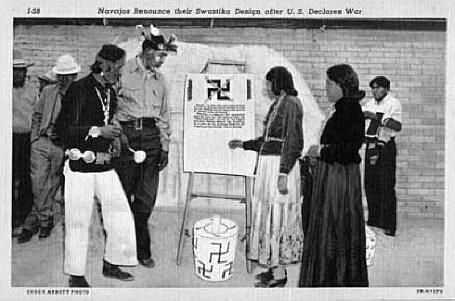







American Indian Swastikas
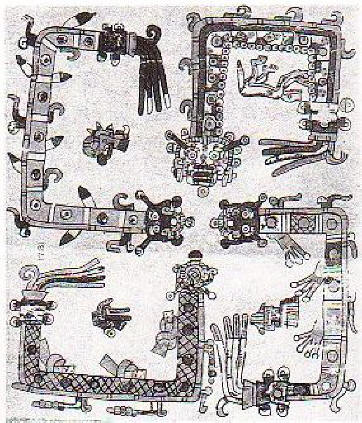
Mayan Swastika
Original Early Symbol for Christianity, 2nd & 3rd Century


Original Early Symbol for Christianity, 2nd & 3rd Century
Swastika in Hinduism
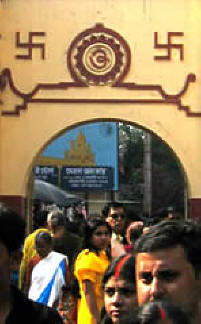





Swastika in Hinduism

Swastika in Jainism
Swastika in Buddhism
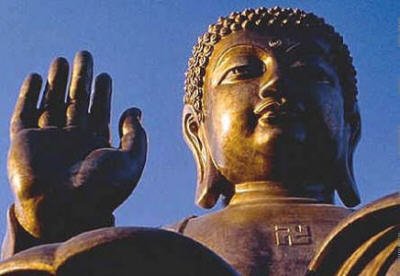








Swastika in Buddhism


Swastika in Islam

Theosophy
Swastika Flags




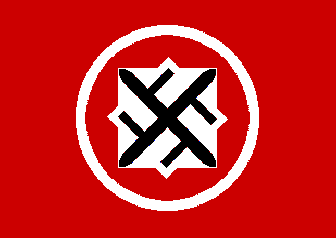


Swastika Flags
Good Luck Swastika




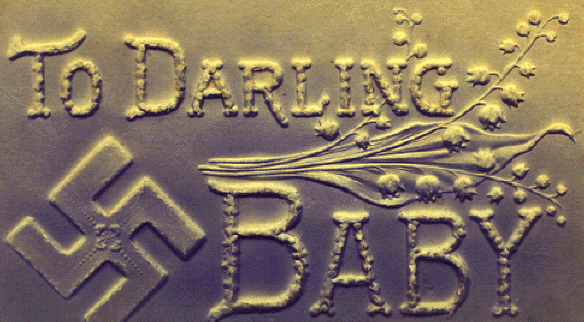
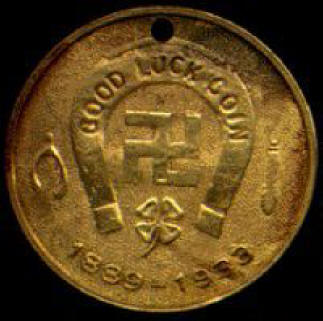
Good Luck Swastika
Curious Swastika




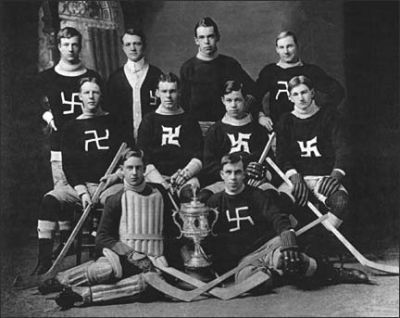


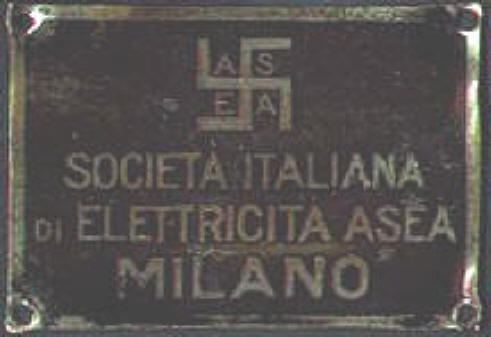

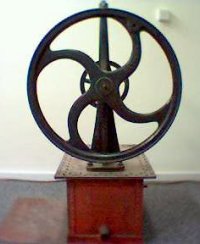

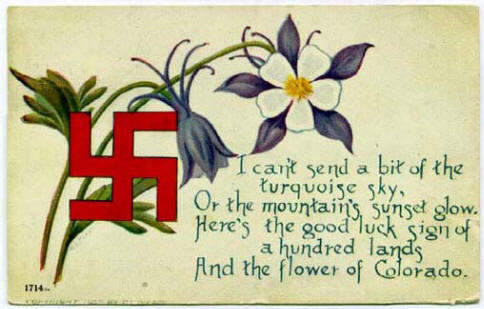
Curious Swastika
Joseph Gill has talked for over 8 hours on national syndicated talk radio shows with 6 to 7 million listeners about symbolism and the simple origins of our different world religions. After many personal requests Joseph has put together this simple picture documentary article for easy understanding and has supplied references for those people wanting more information details. Go as far as you want.
This paper is given after 40 years of research in thousands of books and 50 years of travel 1961-2011; personally visiting hundreds of churches and temples in over 100 countries.
PLEASE FORWARD THIS LINK TO ALL ON YOUR EMAIL LIST
Bibliography (author’s favorites):
The
Swastika, the Earliest Known Symbol, and Its Migrations - Thomas Wilson 1894 A.O
On the Meaning and Origin of the Fylfot and Swastika - Robert Philips Greg 1884
A.O
Debunking the Nazi Backwards Swastika Myth - L. A. Waddell, ETC
The Swastica and the Nazis - Servando González
The Natural Genesis, Vol 1 of 2 or 2nd Part of A Book of the Beginnings -
Gerald Massey 1883
Personal Notes for the more deeply interested, from the Author
ENCYCLOPEDIC THEOSOPHICAL GLOSSARY, Gottfried de Purucker (1347 pages) Jan 2002
Swastika svastika (Sanskrit) An auspicious or lucky object; especially applied to the mystic symbol -- a cross with four equal arms, the extremities of which are bent sharply at right angles, all in the same direction -- marked upon persons and things in order to denote good luck, although originally the symbol had a far deeper significance. Sometimes the arms are bent to the left, sometimes to the right. The symbol is very widespread, and extremely ancient, engraved on every rock-temple and prehistoric building in India, and wherever Buddhists have flourished, as well as in Greece, among the ancient Scandinavians, and in ancient America. It has been called the Jaina Cross; Fylfot, Mjolnir, or Thor's Hammer by the Scandinavian peoples; and in the Chaldean Book of Numbers the Worker's Hammer.
One of the most comprehensive, important, and philosophically scientific symbols, it is a symbolic summary of the whole work of evolution in cosmos and man, from Brahman down to the smallest biological unit. "Few world-symbols are more pregnant with real occult meaning than the Swastica. It is symbolized by the figure 6; for, like that figure, it points in its concrete imagery, as the ideograph of the number does, to the Zenith and the Nadir, to North, South, West, and East; . . . It is the emblem of the activity of Fohat, of the continual revolution of the 'wheels,' and of the Four Elements, the 'Sacred Four,' in their mystical, and not alone in their cosmical meaning; further its four arms, bent at right angles, are intimately related . . . to the Pythagorean and Hermetic scales. One initiated into the mysteries of the meaning of the Swastica, say the Commentaries, 'can trace on it, with mathematical precision, the evolution of Kosmos and the whole period of Sandhya.' Also 'the relation of the Seen to the Unseen,' and 'the first procreation of man and species' " (SD 2:587). The bent arms also signify the continual revolution of the invisible cosmos of forces, which on our plane becomes the revolution in time of the world's axes and their equatorial belts. In alchemy its shows that by the unceasing revolution of the four elements, equilibrium about a stable center is attained, the circle is generated out of straight lines, the complex and changeful nature becomes one. The two crossed lines represent spirit and matter, male and female, positive and negative. It shows man to be a link between heaven and earth, for the horizontal arm having one hook pointing up, the other down. In its applicability to all planes it contains the key to the seven great mysteries of kosmos.
1 - THE THEOSOPHICAL GLOSSARY - H. P. BLAVATSKY 1892
Svastika (Sk.). In popular notions, it is the Jaina cross, or the “four-footed” cross (croix cramponnée). In Masonic teachings, “the most ancient Order of the Brotherhood of the Mystic Cross” is said to have been founded by Fohi, 1,027 B.C., and introduced into China fifty-two years later, consisting of the three degrees. In Esoteric Philosophy, the most mystic and ancient diagram. It is “the originator of the fire by friction, and of the ‘ Forty-nine Fires’.” Its symbol was stamped on Buddha’s heart, and therefore called the “ Heart’s Seal”. It is laid on the breasts of departed Initiates after their death ; and it is mentioned with the greatest respect in the Râmâyana. Engraved on every rock, temple and prehistoric building of India, and wherever Buddhists have left their landmarks; it is also found in China, Tibet and Siam, and among the ancient Germanic nations as Thor’s Hammer. As described by Eitel in his Hand-Book of Chinese Buddhism. . (1) it is “found among Bonpas and Buddhists”; (2) it is “one of the sixty-five figures of the Sripâda” ; ( it is “the symbol of esoteric Buddhism” ; (4) “the special mark of all deities worshipped by the Lotus School of China”. Finally, and in Occultism, it is as sacred to us as the Pythagorean Tetraktys, of which it is indeed the double symbol.
Forlong, Faiths of Mankind - A Cyclopedia of Religions, Vol. 1 – 3
Svastika. Swastika. The name of this emblem is derived
from the expression Su-asti, or “ be thou well.” It is a cross with
feet, but may have three legs instead of four (see Fylfot). The fourlegged
emblem is very ancient, being found on the Hittite monument
of Ibreez in Lycaonia, at Mycenæ, on the pelvis of a naked female
image at Troy, on rocks in Cornwall, and in many other ancient ruins.
It is a symbol of the sun, of fire, and of thunder—the hammer of
Thor. The Hindus also apply the name to a man standing with legs
and arms extended ; and this likewise is an early Hittite and
Phoenician emblem. The sign seems to represent the wheel of the
sun (see Ixion, and Sun) ; the Hindu parent marks it on the breast
and forehead of his babe at birth (see Bombay Rl. Asiatic Socy.,
iii, 1893) ; and a Svastika is formed of wheat ears in the natal
chamber ; the sign (or Kunku) is made with red powder in honour of
Ganesa, and Hindu writers place a red Svastika (or Sri-vatsa) at the
beginning and at the end of MSS. and books ; it is also sketched
in flour on floors, and on garden paths, at wedding fetes. In the
ordinary form , which is called “ male,” the feet follow the direc-tion
of the sun's course in heaven ; this is the Greek Gammadion,
the “ Croix Cramponée,” or Crux Ansata, the Tetra-skelē, sometimes
formed by two letters S at right angles. The opposite emblem is the
“ female,” or Sau-svastika, which is sometimes of evil omen. The Triskelē
(“ three legged ”), or Triquetra, is a similar emblem with
only three legs, and is common on Sicilian coins, as well as in the
Isle of Man. This sacred cross was known among Mexicans, and
apparently to the mound builders of Ohio in N. America (Prof. Wright,
Quarterly Stat. Pal. Expl. Fund, October 1894), and also in Peru,
where it occurs on early pottery. It was probably of Turanian origin,
but is widely spread, on Indian coins and in Skandinavia alike. In India
it is often drawn with long crooks, so as to suggest that originally it
was a circle divided into four by cross lines, and representing the sun.
Among Buddhists it was made into a Chakra or “ wheel of the Law ”
(see Buddha), and by Tibetans it is called Yun-drun, or “ path of life. ”
It is found in Greece, Krete, Cyprus, and Rhodes, and was the emblem
of Artemis, and of Athēnē. It occurs in Thrakia, and in Magna-
Grecia—or S. Italy—on fibulæ from Cumæ, on a Samnite tomb, at
Cære, and at Capua. It was used, apparently by Christians, in the
Roman catacombs, on garments of priests, and of the “ Good Shepherd.”
It was a charm on bells in Yorkshire, and on vases, and arms, in
Switzerland, and among Saxons and Kelts ; on Gaulish coins from the
3rd to the 6th centuries A.C., and on Roman tombs at Algiers ; on the
coins of Parthians and Sassanians in Persia, and on old Phoenician
seals, as well as in Belgium down to our 14th century.
Count d’Alviella (Migration of Symbols, p. 81) traces this widespread
and ancient symbol from Troy and Mycenæ down to the 9th
century A.C. in Ireland, and finds it in Persia, China, N. Africa, and
Skandinavia, in Tibet and Japan. The introduction into America
appears to have been due to the Buddhists of our 5th century. In
Thrakia the Svastika has a central circle, and is accompanied by the
letters MES in Greek. This coin was discovered by Mr P. Gardner,
and appears to have belonged to the city Mesembria, named from the
“ midday sun.” A Lycian coin of the 6th century B.C., also bears the
Triquetra, or three-legged emblem. The Svastika is found throughout
Europe, as at Bishop Island on the Oder, or on a vase from
Reichersdorf, or all round the pulpit of St Ambrose at Milan.
There are 1000 instances in the Roman Catacombs, and others on the
walls of Pompeii : on a Keltik urn found at Shropham in Norfolk ; and
in the Roman villa at Beading in the Isle of Wight ; on Athenian
and Corinthian vases ; on coins of Leucas and of Syracuse ; on a mosaic
in the royal garden at Athens. The Skandinavian S form occurs on
the Ogham sto.ne at Pen-Arthur, in S. Wales, as well as on the altar
frontal of the cathedral at Valentia said to have been sent from Old
St Paul’s in London in the time of Henry VIII. It is common on
Persian carpets, and found in both Hungary and Ashanti, as well as
in Yukatan. The Japanese may still be seen stamping this emblem
as the ancients did in Egypt, or in Cyprus. Mr Aynsley regards the
Gammadion on the tomb of St Agnes in Rome as an “ old Christian
cross.” The Triskelē at Eryx in Sicily is older than 400 B.C. The
Svastika on the stones of the Buddhist stupa at Sar-nāth (in Banāras)
may be yet older. It uccurs twice in the cells by the “ red gate ” of
the mosk at Jaunpūr, and used to be seen at Granada ; but Moslems
disowned it, saying it was placed there by the devil. Hindus often
decorate the Svastika with leaves, flowers, and gold. It is recognised
as representing the two fire sticks (see Arani), as Emile Burnouf
noticed long ago (see Mr Hewitt, Journal Rl. Asiatic Socy., April 1889, p. 189) ;
and in this connection it has a phallic significance, as
rema.rked by Dr J. G. Müller (see also Mr R. Sewell, Indian Antiq..,
.July 1881). In S.W. Asia the feet seem to be turned indifferently
to right or left (Indian Antiq., April 1886). See Triskelion.
Triskelion. Triskele. Triquetra. See Svastika. This is
the “ three-legged ” emblem, which appears to represent the sun’s
movement. Dr Isaac Taylor regards it as of Phoenician origin (see
Notes and Queries, 11th June 1887). It is common on early coins,
and in Greece a Gorgonian face sometimes forms the centre round
which the three legs revolve. It occurs on an electrum coin of Milētos
(623 B.C.) with the crescent moon ; in Thrakia also almost as early :
in Lukia (Lycia) from 480 B.C. downwards, the feet being represented
by cocks’ heads. In Sicily the Triquetra appears in 300 B.C. ; it appears
in Britain not only as the emblem of the Isle of Man, but also
as the coat of several families (Count d’Alviella, Migrat. of Symbols.
1892). When Alexander III of Scotland expelled the last Norman
ruler from the Isle of Man in 1264, and King Hako was forced to
cede it to Scotland, the Norse standard of the ship was replaced by
the Sicilian emblem, Sicily having been accepted by Henry III, the
father-in-law of Alexander, on behalf of his son the Duke of Lancaster.
In the time of Edward I we find the three legs clad in armour, but
the Sicilian emblem was always one with three naked legs.
The Secret Doctrine - H. P. Blavatsky 1888
These seven vowels are represented by the Swastika signs on the crowns of the seven heads of the Serpent of Eternity, in India, among esoteric Buddhists, in Egypt, in Chaldea, etc. etc., and among the Initiates of every other country. It is on the Seven zones of post mortem ascent, in the Hermetic writings, that the "mortal" leaves, on each, one of his "Souls" (or Principles); until arrived on the plane above all zones he remains as the great Formless Serpent of absolute wisdom -- or the Deity itself. The seven-headed serpent has more than one signification in the Arcane teachings. It is the seven-headed Draco, each of whose heads is a star of the Lesser Bear; but it was also, and pre-eminently, the Serpent of Darkness (i.e., inconceivable and incomprehensible) whose seven heads were the seven Logoi, the reflections of the one and first manifested Light -- the universal LOGOS.
To this theological assumption there are several answers. Firstly, the ansated Egyptian cross, or tau, the Jaina cross, or Swastica, and the Christian cross have all the same meaning. Secondly, no peoples or nations except the Christians gave the significance to the Dragon that is given to it now. The serpent was the symbol of WISDOM; and the Bull (Taurus) the symbol of physical or terrestrial generation. Thus the latter, pushing off the Dragon, or spiritual, Divine Wisdom, with the Tau, or Cross -- which is esoterically "the foundation and framework of all construction" -- would have an entirely phallic, physiological meaning, had it not still another significance unknown to our Biblical scholars and symbologists. At any rate, it shows no special reference to the Verbum of St. John, except, perhaps, in a general sense. The taurus (which, by the way, is no lamb, but a bull) was sacred in every Cosmogony, with the Hindus as with the Zoroastrians, with the Chaldees as with the Egyptians. So much, every schoolboy knows.
In that very learned work, "The Natural Genesis," by Mr. Gerald Massey, on
pp. 408-455 (Vol. I.), under the heading, "Typology of the Cross," there is more
information to be had on the cross and circle than in any other work we know of.
He who would fain have proofs of the antiquity of the Cross is referred to these
two volumes. The author shows that "the circle and the cross are inseparable. .
. . The crux ansata unites the circle and cross of the four corners. From this
origin they came to be interchangeable at times. For example, the Chakra, or
Disk of Vishnu, is a circle. The names denote the circling, wheeling round,
periodicity, the wheel of time. This the god uses as a weapon to hurl at the
enemy. In like manner, Thor throws his weapon, the Fylfot, a form of the
four-footed cross (Swastica) and a type of the four quarters. Thus the cross is
equivalent to the circle of the year. . . . The wheel emblem unites the cross
and circle in one, as does the hieroglyphic cake and the Ankh-te ![]() ."
."
Another form of the cross is given from the Journal of the Royal Asiatic Society (vol. xviii., p. 393, pl. 4): --
"At
each of the four corners is placed a quarter arc of an oviform curve, and when
the four are put together they form an oval; thus the figure combines the cross
with the circle round in four parts, corresponding to the four corners of the
cross. The four segments answer to the four feet of the Swastica cross and the
Fylfot of Thor. The four-leaved lotus flower of Buddha, is likewise figured at
the centre of this cross, the lotus being an Egyptian and Hindu type of the four
quarters. The four quarter arcs, if joined together, would form an ellipse, and
the ellipse is also figured on each arm of the cross. This ellipse therefore
denotes the path of the earth . . . . Sir J. Y. Simpson copied the following
specimen ![]() ,
which is here presented, as the cross of the two equinoxes and the two solstices
placed within the figure of the earth's path.
,
which is here presented, as the cross of the two equinoxes and the two solstices
placed within the figure of the earth's path.
[[Vol. 2, Page]] 556 THE SECRET DOCTRINE.
The four arms of the "![]() ,"
the decussated cross, and of the "Hermetic," pointing to the four cardinal
points -- were well understood by the mystical minds of the Hindus, Brahmins and
Buddhists, thousands of years before it was heard of in Europe; and that symbol
was and is found all over the world. They bent the ends of that cross and made
of it their Swastica
,"
the decussated cross, and of the "Hermetic," pointing to the four cardinal
points -- were well understood by the mystical minds of the Hindus, Brahmins and
Buddhists, thousands of years before it was heard of in Europe; and that symbol
was and is found all over the world. They bent the ends of that cross and made
of it their Swastica  now
the Wan of the Buddhist Mongolian.* It implies that the "Central point"
is not limited to one individual, however perfect. That the Principle
(God) is in Humanity, and Humanity, as all the rest, is in it, like drops of
water are in the Ocean, the four ends being toward the four cardinal points,
hence losing themselves in infinity.
now
the Wan of the Buddhist Mongolian.* It implies that the "Central point"
is not limited to one individual, however perfect. That the Principle
(God) is in Humanity, and Humanity, as all the rest, is in it, like drops of
water are in the Ocean, the four ends being toward the four cardinal points,
hence losing themselves in infinity.
Isarim, an Initiate, is said to have found at Hebron, on the dead body of Hermes, the well known Smaragdine tablet, which, it is said, contained the essence of Hermetic wisdom . . . . "Separate the earth from the fire, the subtile from the gross . . . . Ascend from the earth to heaven and then descend again to earth" was traced on it. The riddle of the cross is contained in these words, and its double mystery is solved -- to the Occultist.
"The philosophical cross, the two lines running in opposite directions, the horizontal and the perpendicular, the height and breadth, which the geometrizing Deity divides at the intersecting point, and which forms the magical as well as the scientific quaternary, when it is inscribed within the perfect square, is the basis of the occultist. Within its mystical precinct lies the master-key which opens the door of every science, physical as well as spiritual. It symbolizes our human existence, for the circle of life circum-
* The Swastica is certainly one of the oldest symbols of the Ancient Races. In our century, says Kenneth R. H. Mackenzie (Royal Masonic Cyclopeadia) it (the Swastica) "has survived in the form of the mallet" in the Masonic Fraternity. Among the many "meanings" the author gives of it, we do not find, however, the most important one, masons evidently not knowing it.
So it is, but the spirit of it has been ever misunderstood. "To crucify
before (not against) the sun" is a phrase used of initiation. It comes from
Egypt, and primarily from India. The enigma can be unriddled only by searching
for its key in the Mysteries of Initiation. The initiated adept, who had
successfully passed through all the trials, was attached, not nailed,
but simply tied on a couch in the form of a tau ![]() (in
Egypt) of a Svastika without the four additional prolongations (thus:
(in
Egypt) of a Svastika without the four additional prolongations (thus: ![]() ,
not
,
not  )
plunged in a deep sleep (the "Sleep of Siloam" it is called to this day among
the Initiates in Asia Minor, in Syria, and even higher Egypt). He was allowed to
remain in this state for three days and three nights, during which time his
Spiritual Ego was said to confabulate with the "gods," descend into Hades,
Amenti, or Patala, (according to the country), and do works of charity to the
invisible beings, whether souls of men or Elemental Spirits; his body remaining
all the time in a temple crypt or subterranean cave. In Egypt it was placed in
the Sarcophagus in the King's Chamber of the Pyramid of Cheops, and carried
during the night of the approaching third day to the entrance of a gallery,
where at a certain hour the beams of the rising Sun struck full on the face of
the entranced candidate, who awoke to be initiated by Osiris, and Thoth the God
of Wisdom.
)
plunged in a deep sleep (the "Sleep of Siloam" it is called to this day among
the Initiates in Asia Minor, in Syria, and even higher Egypt). He was allowed to
remain in this state for three days and three nights, during which time his
Spiritual Ego was said to confabulate with the "gods," descend into Hades,
Amenti, or Patala, (according to the country), and do works of charity to the
invisible beings, whether souls of men or Elemental Spirits; his body remaining
all the time in a temple crypt or subterranean cave. In Egypt it was placed in
the Sarcophagus in the King's Chamber of the Pyramid of Cheops, and carried
during the night of the approaching third day to the entrance of a gallery,
where at a certain hour the beams of the rising Sun struck full on the face of
the entranced candidate, who awoke to be initiated by Osiris, and Thoth the God
of Wisdom.
Again, let the reader read the Hindu "fables," as the Orientalists call them, and remember the allegory of Visvakarma, the creative power, the great architect of the world, called in the Veda "the all-seeing god," who "sacrifices himself to himself" (the Spiritual Egos of mortals are his own essence, one with him, therefore). Remember that he is called Deva Vardhika "the builder of the gods" and that it is he who ties (the Sun) Surya, his son-in-law, on his lathe, in the exoteric allegory; on the Swastika, in esoteric tradition, as on earth he is the Hierophant Initiator, and cuts away a portion of his brightness. Visvakarma, remember again, is the Son of Yoga-Siddha, i.e., the holy power of Yoga, and the fabricator of the "fiery weapon," the magic Agneyastra. The narrative is given more fully elsewhere. The author of the Kabalistic work so often quoted from, asks: --
"The theoretical use of crucifixion must have been somehow connected with the personification of this symbol (the structure of the garden of Paradise symbolized by a crucified man). But how? And as showing what? The symbol was of the origin of measures, shadowing forth creative law or design. What practically, as regards humanity, could actual crucifixion betoken? Yet, that it was held as the effigy of some mysterious working of the same system, is shown from the very fact of the use. There seems to be deep below deep as to the mysterious workings of these number values -- (the symbolization of the connection of 113 : 355, with 20612 : 6561, by a crucified man). Not only are they shown to work in the Kosmos . . . . but by sympathy, they seem to work out conditions relating to an unseen and spiritual world, and the prophets seem to have held knowledge of the connecting link. . . . Reflection becomes more involved when it is considered that the power of expression of the law, exactly, by numbers, clearly defining a system, was not the accident of the language, but was its very essence, and of its primary organic construction; therefore, neither the language, nor the mathematical system attaching to it, could be of man's invention, unless both were founded upon a prior language, which afterwards became obsolete . . . " (p. 205).
There was a time, when the Eastern symbol of the Cross and Circle, the Swastica, was universally adopted. With the esoteric (and, for the matter of that, exoteric) Buddhist, the Chinaman and the Mongolian, it means "the 10,000 truths." These truths, they say, belong to the mysteries of the unseen Universe and primordial Cosmogony and Theogony. "Since Fohat crossed the Circle like two lines of flame (horizontally and vertically), the hosts of the Blessed Ones have never failed to send their representatives upon the planets they are made to watch over from the beginning." This is why the Swastica is always placed -- as the ansated Cross was in Egypt -- on the breasts of the defunct mystics. It is found on the heart of the images and statues of Buddha, in Tibet and Mongolia. It is the seal placed also on the hearts of the living Initiates, burnt into the flesh, for ever, with some. This, because they have to keep those truths inviolate and intact, in eternal silence and secrecy to the day these are perceived and read by their chosen successors -- new Initiates -- "worthy of being entrusted with the ten thousand perfections." So degraded, however, has it now become, that it is often placed on the headgear of the "gods," the hideous idols of the sacrilegious Bhons, the Dugpas (Sorcerers) of the Tibetan borderlands; until found out by a Galukpa and torn off together with the head of the "god;" though it would be better were it that of the worshipper which was severed from the sinful body. Still, it can never lose its mysterious properties. Throw a retrospective glance, and see it used alike by the Initiates and Seers, as by the priests of Troy (found by Schliemann on the site of that old city). One finds it with the old Peruvians, the Assyrians, Chaldeans, as well as on the walls of the old-world cyclopean buildings; in the catacombs of the New world, and in those of the Old (?), at Rome, where, because the first Christians are supposed to have concealed themselves and their religion, it is called Crux Dissimulata.
"According to de Rossi, the Swastica from an early period was a favourite form of the cross employed with an occult signification, which shows the secret was not that of the Christian cross. One Swastica cross in the catacombs is the sign of an inscription which reads [['ZOTIKO ZOTIKE]],' 'Vitalis Vitalia,' or 'life of life.' "*
But the best evidence to the antiquity of the cross is that which is brought forward by the author of Natural Genesis on page 433.
"The value of the cross," says Mr. Massey, "as a Christian symbol, is supposed to date from the time when Jesus Christ was crucified. And yet in the 'Christian' Iconography of the Catacombs no figure of a man appears upon the Cross during the first six or seven centuries. There are all forms of the cross except that -- the alleged starting-point of the new religion. That was not the initial but the final form of the Crucifix.** During some six centuries after the Christian era the foundation of the Christian religion in a crucified Redeemer is entirely absent from Christian art! The earliest known form of the human figure on the cross is the crucifix presented by Pope Gregory the Great to Queen Theodolinde of Lombardy, now in the Church of St. John at Monza, whilst no image of the Crucified is found in the Catacombs at Rome earlier than that of San Giulio, belonging to the seventh or eighth century. . . . There is no Christ and no Crucified; the Cross is the Christ even as the Stauros cross was a type and a name of Horus, the Gnostic Christ. The Cross, not the Crucified, is the essential object of representation in its art, and of adoration in its religion.
Few world-symbols are more pregnant with real occult meaning than the Swastica. It is symbolized by the figure 6; for, like that figure, it points in its concrete imagery, as the ideograph of the number does, to the Zenith and the Nadir, to North, South, West, and East; one finds the unit everywhere, and that unit reflected in all and every unit. It is the emblem of the activity of Fohat, of the continual revolution of the "wheels," and of the Four Elements, the "Sacred Four," in their mystical, and not alone in their cosmical meaning; further, its four arms, bent at right angles, are intimately related, as shown elsewhere, to the Pythagorean and Hermetic scales. One initiated into the mysteries of the meaning of the Swastica, say the Commentaries, "can trace on it, with mathematical precision, the evolution of Kosmos and the whole period of Sandhya." Also "the relation of the Seen to the Unseen," and "the first procreation of man and species."
To the Eastern Occultist the TREE of Knowledge in the Paradise of man's own heart, becomes the Tree of Life eternal, and has nought to do with man's animal senses. It is an absolute mystery that reveals itself only through the efforts of the imprisoned Manas and the Ego to liberate themselves from the thraldom of sensuous perception and see, in the light of the one eternal present Reality. To the Western Kabalist, and now far more to the superficial Symbologist, nursed in the lethal atmosphere of materialistic science, there is but one chief explanation of the mysteries of the Cross -- its sexual element. Even the otherwise spiritualistic modern commentator discerns in the Cross and Swastica, this feature before all others.
"The cross was used in Egypt as a protecting talisman and a symbol of saving power. Typhon, or Satan, is actually found chained and bound to the cross. In the Ritual, the Osirian cries, 'The Apophis is overthrown, their cords bind the South, North, East, and West, their cords are on him. Har-ru-bah has knotted him.'* These were the cords of the four Quarters, or the cross. Thor is said to smite the head of the Serpent with his hammer . . . a form of Swastica or four-footed Cross. . . . In the primitive sepulchres of Egypt the model of the Chamber had the form of a Cross.** The pagoda of Mathura . . . the birth-place of Krishna, was built in the form of a Cross . . . .
When the symbolism was needed for another event, then, in conjunction with the seven sidereal sisters, Karttikeya is seen accompanied by Kaumara (or Sena) his female aspect. He is then riding on a peacock -- the bird of Wisdom and Occult Knowledge, and the Hindu Phoenix, whose Greek relation with the 600 years of Naros is well-known. A six-rayed star (double triangle) a Swastica, a six and occasionally seven-pointed crown is on his brow; the peacock's tail represents the sidereal heavens; and the twelve signs of the Zodiac are hidden on his body; for which he is also called Dwadasa Kara," ("the twelve-handed"), and Dwadasaksha, "twelve-eyed." It is as Sakti-dhara, however, the "Spear-holder," and the conqueror of Taraka, "Taraka-jit," that he is shown most famous.
The Natural Genesis, Vol 1 of 2 or 2nd Part of A Book of the Beginnings - Gerald Massey 1883
Page 404
When the Druids shaped the Tree into the Tau-Cross, they
were turning it into a masculine Tree of Life; and in the Cross
of the four quarters the Tree had become prominently masculine.
Hence it interchanges with the fourfold phallus, and both have one
name as the Tat (Eg.) j and the Cross within the Circle (or in connection
with the Ru, the Rosary, or other feminine figure) is the same
symbol of the male Tree of Life twinned and blended with the
female as the fourfold linga or the four-cornered Swastika in the
Tomb, or the Square that is figured with the Circle in the American
and British Mounds. Perhaps the most primitively perfect type of
this sexual duality is that which is figured in the Long-horned Cairn,
the chamber of which has the shape of the uterus within, and the
four horns at the comers correspond to· the four-footed Cross and
the fourfold phallus without.1 Thus, from first to last, the symbols
retain and show the impress of nature's primordial mould.
It was at the top of the tree of heaven-the pole-that the Guaranis
were to meet once more with their Adam, Atum, Tum, or Tamoi, who
was to help them from thence in their ascent to the higher life.
Here the Tree of Life becomes a tree of the dead to raise them into
Heaven. So in the Algonkin Myth the tree of the dead was a
sort of oscillating log for the deceased to cross the river by as a bridge
of the abyss, beyond which the Dog-as in the Persian Mythosstands
waiting for the souls of the dead, just as the Dog stands at the
Northern Pole of the Egyptian Planisphere,2 and is depicted in the
tree of the Southern Solstice-the tree of the pole which was extended
to the four quarters.
Page 419
The square was held by the Pythagoreans and Neo-Platonists to be
the symbol of earth, and inferior to the circle, the symbol of heaven.
The square in the language of heraldry is a diminished or broken
circle, the circle being the square perfected. This is imaged by the
Swastika cross, the four feet of which show segments of the circle
broken and reduced to form the square.
The square is of course an angle of ninety
Page 422
A most curious form of the cross is given in the Journal of tlte Royal
Asiatic Society.? At each of the four corners is placed a quarter arc
of an oviform curve, and when the four are put together they form
an oval; thus the figure combines the cross with the circle round
it in four parts, corresponding to the four corners of the cross. The four
segments answer to the four feet of the Swastika cross and the Fylfot
of Thor. The four-leaved lotus flower of Buddha is likewise figured at
the centre of this cross, the lotus being an Egyptian and Hindu type
of the four quarters. The four quarter arcs, if joined together,
would form an ellipse, and the ellipse is also figured on each arm of
the cross. This ellipse therefore denotes the path of the earth.
Now the symbol depicted on the Scottish stones and commonly
known as the "spectacles ornament" is, as previously suggested, a
form of the cross of the four quarters j a symbol of the solstices and
equinoxes. This is also drawn within the ellipse upon the sculptured
stones of Scotland. Sir J. Y. Simpson copied the following specimen, ..u
which is here presented as the cross of the two equinoxes and
'9 the two solstices placed within the figure of the earth's path. The
same ovoid or boat-shaped figure appears at times in the Hindu
drawings with seven steps at each end as a form or a mode of Meru.
The four-armed cross is simply the cross of the four quarters,
but the cross-sign is not always simple. This is a type that
was developed from an identifiable beginning which was adapted
to the expression of various ideas afterwards. The most sacred
cross of Egypt that was carried in the hands of the Gods, the
Pharaohs, and the mummied dead is the Ankh ~, the sign of
life, the living. an oath, a covenant, and a pair, or to couple
and duplicate. The top of this is the hieroglyphic Ru <=>, set
upright on the Tau-cross. The Ru is the door, gate, mouth, the place
of outlet. This denotes the birthplace in the northern quarter of the
heavens from which the sun is re-born. Hence the Ru of the Ankhsign
is tlte feminine type of tlte birthplace representing lite nortlt. It
was in the northern quarter that the goddess of the Seven Stars, called
the" Mother of the Revolutions," gave birth to time in the earliest
circle of the year. The first sign of this primordial circle and cycle
made in heaven is the earliest shape of the Ankh-cross. ~, a mere
loop which contains both a circle and the cross in one image. This loop
or noose is carried in front of the oldest genitrix, Typhon of the Great
Bear, as her A rk, the ideograph of a period, an ending, a time, shown
to mean one revolution. This, then, represents the circle made in the
northern heaven by the Great Bear which constituted the earliest
year of time, from which fact we infer that the loop or Ru of the
north represents that quarter, the birthplace of time when figured as
the Ru of the Ankh symbol. Indeed this can be proved. The noose
is an A rk or Rek type of reckoning. The Ru of the Ankh-cross was
continued in the Cypriote R, .0, and the Coptic Ro, P. The Ro was
carried into the Greek cross, ." which is formed of the Ro and Chi,
or R-k. Thus the Ark (Eg.) sign of the circle and cross survives by
name in the Ro-clti cross, and the connection of the Ru or Rk with
the birthplace can be shown by this name. Ru (Eg.) is the outlet,
and the feminine Kha determines its nature. Rak in Akkadian, like
the Ru-kha, is the vulva. Rakha, in Quichua, is the vagina and the
woman. The Rak, or Ark, was the sign of all beginning (A rclte) on
this account, and the Ark-tie is the cross of the north, the hind part
of heaven. "A rka" in Assyrian is the hinder part, which is represented
by the R u <=>.
The sign, ~,occurs as the reverse of a Phrenician coin, with a Ram
as the obverse. The two represent the front and hinder part, or the
familiar Head and Tail. The same sign, sometimes called Venus'
Looking-Glass, because it typified reproduction, was employed to
mark the hind quarters of valuable brood mares of Corinthian and
other beautiful breeds of horses.1 This was based on the Ruor Ark
sign of the crossing in the north. With the Ru sign set on the statT
thus ?, we have the symbol of north and south, or male and female,
the south being considered the front, before, masculine. A form of
the Ankh Cross found in the fourth pyramid -i- enables me to prove
the origin of this cross as a sign of north' and south, because the pillar
~nd· base are the Pyramid of Sothis, the dog-star. The Pyramid
being both four-square and triangular is a figure of Seven. Hence its
name of Hept or Sebt (Sothis) is the name of number 7. Sothis was
a masculine or southern type of the Goddess of the Seven Stars, who
was thus represented by the Ru of the north and the Pyramid of the
south. The top is the Ru of the birthplace in the north, and the
bottom is the symbol of the south I With the two arms it presents
the figure of above (north), and below (south) with the crossing
east and west, or right hand and left. This istlte complete Ankh-Cross
of Life.
In symbolism nothing dies. The earliest Ankh-sign is the cross
of cord. The Muysca Indians continued this in a very significant
form. They used to stretch a great rope-cross consisting of two cords
over the surface of a pool or a river, and at the point of intersection
they would cast their most precious offerings and tributes into the
water. Such was their offertory of the cross; the cross of the
genitrix, and of the waters. The cross of rope survived in Britain.
Scot in his Discovery of Witchcraft,l mentions a kind of cross made
of a rope's end on Ascension Day, which was looked on as a source
of blessings. The Ankh signified life and reproduction, whether made
of rope or any other material.
The notion of Payne Knight and Inman, that the cross or Tau is
simply a copy of the male organs in a triadic form is radically false.
For instance, Khem.-Horus is the crosser; he wears the cross on his
breast. He exhibits HIS form of the Tat, which is expressly deprived of
two members of the supposed triad of tlte Tau. The Tau cross T, our
letter T, is connected with the number 9. The Coptic Theta, Tida, or
T has the numeral value of 9. In the Greek form the Theta unites the
circle and cross e. The T is a numerical three, a cross of three-quarters
instead of four, and so becomes a figure of nine months, or nine divisions
of tlte twelve which were completed by tlte t!tree water signs, or the
abyss in the north, represented by the 0 of the 9 cross. But the
cross as the Tat and the male emblem have a meeting-point inasmuch
as both are types of establishing. De Rossi found a phallus of
red coral in a tomb which, as he says, might have been suspected
of being Christian did not the presence of this symbol persuade
to the contrary.' But the emblem was not uncommon in the
so-called Christian cemeteries.
Page 426
Gori tried to get the name of Jesus out of the two Zeds of the
Swastika. cross of the catacombs by writing Z for J, and Zezus for
Jesus. But the fact is that Seses is a Gnostic name of Isis, and
the S S S Sistrum (the Sshsh) is a symbol of Isis, the sign of
the female crossed, the three S's or bars being identical with the
. Seses of the Gnostics. Therefore a six-fold cross may be claimed
as a cross of breath. For Ses (Eg.) signifies breath and
number six with an occult allusiveness. Ses also denotes the
attaining of land after crossing the waters, as did the annual sun
when emerging from the water-sign of the Ram or Pisces. The
II Pad rna-Swastika " is a mystical mark consisting of the lotus-flower j
(according to the Scholiast) a four-cornered sort of painting. It is
the lotus-cross figured in the palm of Buddha's hand and upon the
soles of his foot, as well as on his breast, the place of breath.1 The
Lotus, the ascender out of the waters, was a symbol of Breath, and
the Egyptian Sesh,nin (lotus) is the opener, uncloser or breather out
of the waters.
But breath, spirit, and fire are equivalent types of life. In Egyptian
Ses is breath j Suit, flame j Sesk is combustion, also a spirit of wine,
Ziz, or Zizit, was the Rabbinical Bird of Fire or Soul. The Greek
" ~t'JtT'I'J(j I "- Vivas-is a form of wishing life and health. Svas in
Sanskrit also means to breathe and to live. The Svastika, or Swastika
Cross, is a sign of life represented by the vivifying fire, and also
a lingaic symbol (Tika [Eg.] is to cross, join, twist, go together j and
Tik in Sanskrit is to go) j this has the shape of a double Z, and Z Z
has the force of Ziz, Ses, or Svas, denoting the life, the breath, the
generative fire, of wh:ch the Swastika is the Cross.
The Dakotahs have a native name for the cross, which signifies the
"Musquito-Hawk spread out."'1. Here the bird is a type of fire. The
Hawk in Egypt was representative of the soul and the solar fire. The
Creek Indians at -their festival of the Busk commenced with making
the new fire by placing four logs til tlze centre of a square, end to end,
so that they formed a cross, the outer ends pointing to the four
cardinal points, and in the centre of this cros.~ the new fire was
created.s This was another mode of making the Swastika or cross of
fire. In Egyptian II Bus" denotes both fire and protection. This
connection of the cross and fire as interchangeable types of protection
is likewise manifest in the command for the Hebrews to make a fiery
serpent, and elevate it on a stauros or cross pole, which is rendered by
the Targum "Make tlzeea burning;" The four-footed Swastika cross
has been found on the prehistoric pottery of Cyprus, at Herculaneum, in
Egypt, in Ireland, and in England. A leaden figure of the Babylonian
goddess Nana discovered by Dr. Schlie mann at Troy, has this cross
figured on a triangular pelvis. The triangle is a type of fire, and the
Hindus consider the Swastika cross to be the especial emblem of
Agni or fire. Swastika in Sanskrit is the name of various mystical
marks and signs, amongst others the cross, and one particular symbol
made of ground rice, and shaped like a triangle or pyramid, and this
triangle or pyramid was a sign in Egypt of the ancient Horus, as
the virile one of the triad. The Swastika was also used (in India),
for the fumigation of Durga, as a type of the fire that vivifies, after
the period of negation or the water. According to De Rossi the
Swastika from an early period was a favourite form of the cross
employed with an occult signification which shows the secret was not
that of the Christian cross. One Swastika cross in the catacombs is the
sign of an inscription which reads "ZfiTIKfi ZOTIKH Vitalis Vitali a,"
or life of life. The writer of Rome in tke Nineteentlt Century witnesses that
Christ was buried before he was dead, according to the
Christian reckoning; II His body is laid in the sepulchre in all the churches
of Rome, wltere tlte rite is practised, Oil Thursday iIJ tlte forenoon, and
it remains there till Saturday at mid-day, when,for some reason best
known to tltemselves, he is supposed to rise from tlte grave amidst the
firing of Call1lon, and blowing of trompets, and jingling of bells 'Ulhich
have been carefully tied up ever since the dawn of Holy Thztrsday,lest
tlte devil should get itltO tltem."l On the Friday was the day of adoring
tlte cross of fire. A blazing cross was !luspended from the dome of
St. Peter's, a cross being covered with countless lamps, which had the
effect of a perfect figure of fire, shaped cross-wise. .. The whole
church," says the eye-witness, "was thronged with a vast multitude of
all classes and countries, from royalty to the meanest beggar, all gazing
upon this one object. In afew minutes tlte Pope and all his cardinals
descended into St. Peter's, and tlte aged pontiff prostrated himself in silent
adoration before tlte cross of fire." 2 This may explain why the
Swastika cross, the fire .. cross of India, the cross of the generative fire
in Egypt is found in the tombs at Rome. Dante describes the souls
in Paradise as kneeling, praying, and respiring inside a cross of fire
which forms their world. The cross of fire survives in the hot cross
bun, the cake of the vernal equinox, and of the Horus who arose
hawk-headed, the hawk being a symbol of the vivifying fire. The hot
cross buns eaten on Good Friday are believed to protect the house
from fire, which shows the connection with that element. The cross of
fire was continued in the" cross candle" of Easter Eve and Pasche,
also in the candles that used to be consecrated to "light up in
thunder," which was equivalent to making the sign of the cross as the
symbol of stability when the powers of darkness, discord and desolation
were at work overhead. The cross has now been identified with
the three elements of earth, breath, and fire.
Page 439
The Nail, whether as davis or unguis, being a type of virility,
its significance becomes apparent wherever the Nail is a symbol.
Burton, our modern opener of Central Africa, found that the negroes
there would .drive a nail into' the" Devil's Tree" as a charm against
disease.1 The meaning was the same as that of the Nail in the tomb,
the nail in the corners of the Swastika, in the body of Buddha or
Krishna; the nail that figured the masculine potency of the Soter,
Saver, Preserver, and Healer, with which the primitive man contended
against the Devil, Disease, and Dissolution. It was the weapon
of his manhood, whether this might be represented by the nail, the
hieroglyphic naklt, or allkh, pubes, horn, stone, metal, or the member.
Tertullian, in his taunting of the non-Christians with their use of
the same symbols as the Christians, asks with regard to the cross
.. Dotlt tlte Atltenian Minerva differ from tlte body of tlte cross, and the
Keres of Pltaros wlto appeared in tlte market witlt a figure made of a rude
and sltapeless stake? TIte origin of your cross is derived from figures
mounted on tlte cross. All those rows of images 011 your standards are
tlte ~ppendages of crosses. Tltose ltangings on your standards alzd
bamlers are lite robes of crosses." As if the cross of Christianity were
the original of these I Whether innocence or impudence, it is imperturbable.
Except in a dark void of human ignorance there was no
place left in this world for the cross to become the symbol of salvation
and the type of immortality by man or god being sacrificed upon it.
According to the Septuagint, the cross 2 was the symbol of salvation,
just as it had been for ages and in divers forms when buried with the
mummies in Egyptian tombs, with no earthly relationship to an
historical crucifixion. It was already the image of immortality in
Egypt, in Chaldea, Britain, India, America, and the Southern Isles,
because it was the cross of life and not a cross of death. And it was
the cross of life because it represented the fourfold foundation of the
world, the four corners of the human abode; because it was an emblem
of reproduction, an image of duration, a type of the eternal.
There is a belief yet current amongst our peasantry that one can
hardly die or pass away in peace beneath the cross-beams called the
sign-tree of the house. Many a bedstead has been removed from its
usual place under the cross-beams before the departing spirit could
get release. Thus, after the cross has been for so many centuries held
before the closing human eyes as the s:gn and to~..:en of relief, as the
very hand outstretched by an expiring deity to help the dying mortal
in the panJs of death, this primitive pre-Christian type of stability,
duration, life, and living, remains so potent over minds that are totally
unconscious of its origin and significance that they cannot die whilst
looking at it or lying under it. The sign-tree, or Skhen-tree (the
prop), is the cross-shaped tree of life in Britain, as it was in" Egypt,
India. or Mexico, and here it also survives as the cross of life in
opposition to a cross of death. The cross-type is a continuation of
the tree, and it equates with the tree, the mount, and the conical
pillar of Aphrodite, all three being primary images of the mother of
life and goddess of the four quarters. The mother as the cross was
continued in the Oralzte, who was found in an Etruscan tomb standing
with extended arms over the laid-out body of the dead. 1
The same sign is made by the spiritual body just emerging from
the dead body in the Egyptian drawings, because it is the symbol of
the future life. The Etruscan Orallte survived in Rome where she
forms one of the chief figures in the catacombs. There she is taken
to represent the Church and the Bride of Christ. Call it what you
may, the cruciform Orallte in the cemeteries of Rome or the Etruscan
Tombs or the tombs of Paphos is identical with the ancient mother
of life who holds her cross before her pregnant womb in token of the
life to come. She was the virgin mother, too, who produced without
the fatherhood, and who reprorluces the dead in a later time when the
male progenitor or emblem has been added. The identification of
this virgin mother with the Church is complete in the words of Clement
Alexander, who exclaims: .. 0 Mystic TVonder I The Il1liversal Fat/ler
is one, and one is the Il1lh'ersal Logos or rVord; and the Holy Spirit is
olle and the same ever)"'UJhere, and Olle is the Virgin mother. Her 1I000le
to call the Church! ,. 2 She was the Church as the abode of li Ie continued.
She was also the cross as the Orallle J' the cross that bore the Christ of
the ancient cult; the tree of which the Messiah son was the branch.
The Or ante figure is several times found double; one standing on
either side of the Good Shepherd. the supposed Christ of the catacombs,
like the two divine s:sters on each side of Horus; they who
call him to come to them, to his abode; with one of them, Nephthys,
carrying the house on her head. The latest form of the feminine
abode was the mother Church who becomes twin because it was so in
Egypt.
Page 448
It even depended on the cross being three-armed or four-armed
as to whether the Christ was crucified with three nails or four.
Some sects adored the T -shaped cross and three nails; others
the four-armed cross and four nails. Bishop Luke of Tuy (about
1230) maintained that the nails were four in number. This was
evident from the existence of the fouy gmuine nails which were
still preserved, and which he had sem ill fouy differmt places, to
wit, Nazareth, Tarsus, Constantinople, and St. Denis. The nails
in the hands and feet of Buddha, of Witoba, of Maya, and in the
corners of the Swastika Cross, show that the proper number is
four, in keeping with the Cross of the four Quarters. The cross
on which the Jewish Paschal lamb was spillt'd, was double, and
thus corresponded to the two equinoxes or crossings which the
Hebrews keep.6 This cross of the four quarters and two equinoxes
constitutes that known as the Cross of Lorraine, which has double
arms, and is therefore of a sixfold form. Three French churches are
founded on this model. The great English churches of Beverly,
Page 452 To recapitulate: the earliest sign of the Cross made with the hands
denoted reckoning and repetition; this is extant in the x of multiplication.
The first form of the Celestial Cross was described by the earliest
maker of a circle, which was a constellation that crossed below the horizon.
This was made by the Seven Stars in Ursa Major or the
genitrix who was personified as the bringer-forth of Time in Heaven
and pourtrayed as the enctinte Mother, whose Ankh-Cross (the tie or
cord) was the figure of life to come (for in Iter was life), and of
continuity by means of cyclic repetition. The next was the Cross of
establishing for ever on the four-fold foundation of the four quarters,
with the Tat-pillar as its type, which was first assigned to the lunar
god. Lastly, the Sun-God made the circle and the sign of the Cross
which might be the Tat of the Equinox and Solstice, or the Swastika
with four nails in its four feet; the extended human figure with the
s:gn of four nails in hands and feet; the Cross of the four-fold or the
cubical foundation; the four-fold, six-fold, or seven-fold Lingaic cross.
The Solar God who crossed was the virile potent one, the victor and
conqueror. Hence the Cross became the sign of all that is expressed
by the word KR (Eg.), which not only means a course of time but
Power, Ability, Virile Potency, Support, the Weapon of Power. And
in its final phase as the Christian emblem the Cross of death and
blood-sacrifice offered to the God of Gore, befittingly fulfils its type;
keeps its character, and still gets its drench and drink of human life
as the hilt of the sword by means of which the dominion of the Cross
has been and still continues to be extended over the globe.
In the Christian Iconography the cross is connected with the ram
and the lamb; in each case the animal wears the cross as a glory,
and has another form of the cross for an 'accompaniment. Again,
the name of the fish as IXeTC is placed at the head of the starry
cross.l
In the Hermean Zodiac, Pisces is named Ichton, and the fish is the
female goddess who brought forth the young Sun-god as her fish,'
whether called Horus in Egypt or Marduk the Fish of Hea in
Assyria; Ichthys, who was the son of the fish-tailed Atergatis at
Ascalon,a or Ichthys which was also a title of Bacchus.· The cross
of the ram or lamb, as the symbol of the four quarters is corroborated
by the mount of the four quarters which are represented by the four
rivers of the" Genesis." In monuments of what is termed by Didron
the II Primitive Church," the lamb is frequently seen standing on a
mountain out of which the four rivers flow, as a symbol of the four
quarters. On a sculptured sarcophagus in the Vatican, "belonging
to the earliest ages of Christianity," the lamb is pourtrayed standing
on the mount of the four rivers with the monogram A f b) set in a
circular nimbus.
Ancient Egypt The Light of the World, Vol 1 & 2 - Gerald Massey 1907
At first the form impressed upon the universe, in the Kamite mythology, had been
feminine. It was the womb, the meskhen, or creatory of the Great Mother, as bringerforth
of life and the elements of life. Finally, this was superseded by the image of the
man; the divine man described by Plato, who bicussated and was stamped upon the
universe in the likeness of a cross. Now the new heaven in the Book of Revelation was
formed according to “the measure of a man” (Rev. XXI. 17). This was the heaven
founded on the four cardinal points, which were represented by the cross of the four
quarters. The cross of the four quarters, or the earlier Tat-pillar was a figure of the power
that sustained the universe as the Osiris-Tat or as the later man upon the cross. Thus
the divine man, as the cruciform support of all in Ptah-Sekeri or Osiris, was the prototype
of the Crucified. This god of the four quarters is portrayed as Atum-Ra in the Ritual (ch.
82). It is he who says (by proxy) “My head is that of Ra and I am summed up as Atum,
four times the arm’s length of Ra, four times the width of the world”. Thus Atum, the
divine man, was a quadrangular figure of the four quarters in the heaven founded
according to “the measure of a man” which is reproduced in Revelation. We learn from
the Ritual that man became the measure of the universe in consequence of the god
being divinised in the human form, who in his coming to earth as the heir of Seb says, “I
come before you and make my appearance as the god in the form of a man” (ch. 79); he
who is identified in the same chapter as Atum-Ra. As Atum was the first god who
assumed the form of man, that may account for the new heaven being designed
according to “the measure of a man”, as described in Revelation (XXI. 17, and Rit., ch.
82). This was what took place at Annu when Iu, the son of Atum-Ra, designed the
“temple”, as the new heaven was called. Moreover, as Atum-Ra was the divine man, this
tends to prove that “the son of man” who is Jesus in Revelation was one with Iu, the Su
or son of Atum-Ra. And here it is possible that we come upon the origin of the Swastika
cross as a typical figure of the heaven that was founded on the four corners according to
the measure of a man. From the most primitive forms of the Swastika known we learn
that in its origin it was derived from the human figure. The Swastika found in Egypt
proves it to have been derived from the form of a man. The four limbs, which eventually
became four feet or four legs, were at first the two arms and two legs of the human
figure (Pro. Bib. Arch., Nov.1900). This, then, is the divine man whose image was
extended crosswise on the universe as a type of creation, and who, as Atum in the
character of Iu the son, was the Egyptian Jesus. A portrait of the Good Shepherd has
been discovered in an underground [Page 725] Roman cemetery with the Swastika figured
twice upon his tunic. He carries the pan-pipes in his right hand and comes in the attitude
of dancing (Lanciani, Rodolfo, New Tales of Old Rome, p. 117). This in the mythos was
the youthful solar god, and Horus of the resurrection in the eschatology. “The tabernacle
of God” is now “with men, and he shall dwell with them”. As it had been ever since the
child, as Horus, was incarnated in the blood of Isis, to assume the human figure when
“the Word was made flesh” in the beginning.
END